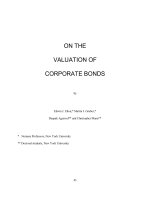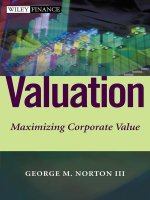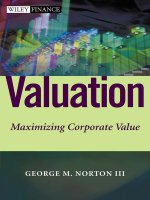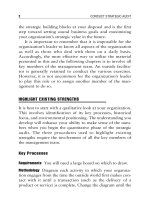Valuation - maximizing corporate value (2003)
Bạn đang xem bản rút gọn của tài liệu. Xem và tải ngay bản đầy đủ của tài liệu tại đây (612.91 KB, 211 trang )
Valuation
Maximizing Corporate Value
GEORGE M. NORTON III
John Wiley & Sons, Inc.
Valuation
F
ounded in 1807, John Wiley & Sons is the oldest inde-
pendent publishing company in the United States. With
offices in North America, Europe, Australia, and Asia,
Wiley is globally committed to developing and marketing
print and electronic products and services for our cus-
tomers’ professional and personal knowledge and under-
standing.
The Wiley Finance series contains books written specifi-
cally for finance and investment professionals, as well as
sophisticated individual investors and their financial advi-
sors. Book topics range from portfolio management to
e-commerce, risk management, financial engineering, valua-
tion, and financial instrument analysis, as well as much
more.
For a list of available titles, visit our web site at
www.WileyFinance.com.
Valuation
Maximizing Corporate Value
GEORGE M. NORTON III
John Wiley & Sons, Inc.
Printed in the United States of America.
10987654321
This book is printed on acid-free paper.
Copyright © 2003 by John Wiley & Sons, Inc. All rights reserved.
Published by John Wiley & Sons, Inc., Hoboken, New Jersey
Published simultaneously in Canada.
No part of this publication may be reproduced, stored in a retrieval system, or
transmitted in any form or by any means, electronic, mechanical, photocopying,
recording, scanning, or otherwise, except as permitted under Section 107 or 108 of
the 1976 United States Copyright Act, without either the prior written permission
of the Publisher, or authorization through payment of the appropriate per-copy fee to
the Copyright Clearance Center, Inc., 222 Rosewood Drive, Danvers, MA 01923,
978-750-8400, fax 978-750-4470, or on the web at www.copyright.com. Requests
to the Publisher for permission should be addressed to the Permissions Department,
John Wiley & Sons, Inc., 111 River Street, Hoboken, NJ 07030, 201-748-6011,
fax 201-748-6008, e-mail:
Limit of Liability/Disclaimer of Warranty: While the publisher and author have used
their best efforts in preparing this book, they make no representations or warranties
with respect to the accuracy or completeness of the contents of this book and
specifically disclaim any implied warranties of merchantability or fitness for a
particular purpose. No warranty may be created or extended by sales representatives
or written sales materials. The advice and strategies contained herein may not be
suitable for your situation. You should consult with a professional where appropriate.
Neither the publisher nor author shall be liable for any loss of profit or any other
commercial damages, including but not limited to special, incidental, consequential, or
other damages.
For general information on our other products and services, or technical support,
please contact our Customer Care Department within the United States at 800-762-
2974, outside the United States at 317-572-3993 or fax 317-572-4002.
Wiley also publishes its books in a variety of electronic formats. Some content that
appears in print may not be available in electronic books.
Library of Congress Cataloging-in-Publication Data:
Norton, George M.
Valuation : maximizing corporate value / George M. Norton III.
p. cm.
Includes index.
ISBN Bookz 0-471-38654-5 (cloth : alk. paper)
I. Management. 2. Strategic planning. 3. Corporate culture.
I. Title.
HD30.28.N677 2003
658.4'012—dc21
2002011161
To Paula
for her patience and support in this
and all my endeavors
acknowledgments
I
want to express my gratitude to my father, who instilled in
me early in life a love and respect for the power and
irrefutability of mathematics. I would also like to thank all
the coeds with whom I came in contact in college, who con-
vinced me that there were better ways to spend four years
than doing engineering homework and that one could enjoy
both math and campus life simultaneously. I would like to
thank my father again. As manager of the pension fund for
one of the big three auto makers for many years, he con-
vinced me that intrinsic company value has little to do with
the nuances of market timing or subtle accounting tech-
niques and tricks. Rather, it is the soundness and logic of
the organization’s business model and the intelligence, expe-
rience, and honesty of its management that determines cor-
porate wealth over the long term.
Next, I would like to thank all my clients over the last
several decades, who have so willingly and openly embraced
the concepts contained herein, especially those whose out-
spoken comments and suggestions have resulted in a contin-
uing evolution of the framework process into the powerful
tool it is today. A special thanks goes to the privately held
and not-for-profit clients, whose naturally long-term per-
spective allowed for many faithful framework executions
and implementations without concern for and the distrac-
tions of reporting quarterly earnings to the public.
vii
Any list of those to whom a debt of gratitude is owed
would not be complete without expressing appreciation to
the many software writers and companies who, over the
years, have made the use of computer spreadsheets and
other analytical tools so simple, complete, and foolproof.
These programs allow employees not only to understand
and contribute to the maximization of the organization’s
value, but also to apply easily the same principles to their
family situations and to increase their personal wealth and
happiness.
Creating the framework is only part of any organiza-
tion’s success story. Making it a reality requires the work of
many. Therefore, I wish to thank the many associates, first
encountered in my early days at The Wharton School of
Finance and Commerce and Booz, Allen and Hamilton.
Over the years, their expertise in market research, informa-
tion technology, executive compensation and recruiting,
quality circles, corporation finance, and other areas in
which clients have had to seek external assistance in order
to execute properly and effectively their framework to
obtain corporate value enhancement has been invaluable.
In summary, I would like to thank all the people who
helped create this book. I owe a great deal to my family for
their support and to all the staff at John Wiley & Sons,
especially my editor, Sheck Cho, whose encouragement and
patience throughout the process kept the flame alive, and
Sujin Hong, whose attention to detail ensured the quality of
the final product. The many practitioners of management
and finance who over the years so willingly share their find-
ings and techniques should not be forgotten. However, any
shortcomings are mine alone.
viii ACKNOWLEDGMENTS
Finally, I would like to thank, in advance, those of you
gracious readers who take the time to contact me with
your comments and suggestions after you apply the frame-
work I have provided in this book. I can be reached at
Acknowledgments ix
xi
contents
Preface xv
CHAPTER 1
Conduct Strategic Audit 1
Highlight Existing Strengths 2
Identify Implicit Strategies 9
Plot Growth Performance 13
Analyze Profitability Ratios 16
Determine Relative Value 18
Summary 20
Endnotes 20
CHAPTER 2
Calculate Current Value 23
Discover Importance of Value 23
Master Discounted Cash Flow 30
Understand Value Drivers 35
Determine Cost of Capital 40
Calculate Current Organization Value 43
Summary 48
Endnotes 48
CHAPTER 3
Assess Strategic Landscape 51
Review Planning Fundamentals 52
Identify Stakeholders 57
Gather Additional Information 61
Define Factors for Success 69
Identify Barriers to Success 73
Summary 73
Endnotes 74
CHAPTER 4
Build Framework Foundation 75
Review Framework Relevance 76
Discover the Process 77
Lay the Foundation 81
Determine Niche Positions and Goals 88
Evaluate Mission, Niches, and Goals 93
Summary 95
Endnotes 96
CHAPTER 5
Formulate Sound Strategies 97
Understand Strategic Thinking 98
Develop Objectives 108
Develop Strategies 113
Select Value-Maximizing Strategies 119
Summary 128
Endnotes 128
CHAPTER 6
Evaluate Alternative Approaches 129
Review the Selected Strategies 130
Understand the Methodology 131
xii CONTENTS
Quantify the Selected Strategies 134
Calculate Revised Case Value 144
Measure Value Enhancement 150
Summary 154
CHAPTER 7
Execute for Value 157
Create Action Plans 158
Plan Implementation 170
Embrace Change 177
Execute the Framework 187
Summary 188
Endnotes 190
Epilogue 191
Index 193
Contents xiii
xv
preface
T
his book is the result of years of experience in assisting
middle-market manufacturing and service entities, as
well as various not-for-profit organizations, in refining and
applying top-management strategy and valuation tech-
niques used by large corporations. Accordingly, it should be
of interest to officers, directors, and managers or advisors
to all types of organizations. It is especially relevant for
people dealing with closely-held firms, autonomous divi-
sions or subsidiaries of publicly-traded companies, county
and local governments, and schools and universities as well
as other medium-sized entities.
This book shows how, by understanding and using a
few, simple concepts, the leaders and members of any type
of organization can enhance their daily and long-term satis-
faction and that of their key stakeholders while simultane-
ously reaping substantial financial rewards. It is a “hands
on” guide to incorporating sound strategic and valuation
principles into decision making throughout the organiza-
tion. It allows leaders and advisors to create a culture in
which people work to achieve their potential and that of
the organization by simultaneously improving the well-
being of all who come in contact with and have an impact
on the organization.
The book is divided into seven chapters. Each chapter
explains what to do, why to do it, and how. Examples using
the ABC Company facilitate the reader’s ability to translate
the techniques discussed to unique, real-world situations. In
order to maximize the book’s usefulness, the organization’s
leader should put together a management team that can
work together throughout the seven major steps presented.
The first three chapters focus on the organization’s his-
tory, worth, and environment. The management team
arrives at a consensus on the organization’s current condi-
tion and its potential. Chapter 1 focuses on conducting a
strategic audit. The exercises enable the participants to
develop an understanding of the implicit strategies that have
taken the organization to the place where it is today.
Chapter 2 presents a methodology to calculate the current
value of the organization. The valuation variables involved
require five years of financial statements. However, younger
or start-up organizations can develop estimates for the vari-
ables and also calculate a current value. Chapter 3 helps the
management team characterize the organization’s strategic
landscape. It reviews the fundamentals of planning and con-
ducting research. It introduces the concept of stakeholders
as all those various groups that have a current or potential
impact on the future of the organization. In addition, it pre-
sents exercises aimed at highlighting the key factors for and
barriers to the organization’s long-term success.
The next three chapters introduce the concept of a
strategic framework and how to use it to develop a founda-
tion for future action. Chapter 4 discusses the importance
and relevance of a strategic framework. It introduces and
defines the major elements of the framework and helps cre-
xvi PREFACE
ate a common language the management team can use
throughout the remaining steps. It presents exercises and
techniques that enable an organization to define its vision,
values, goals, and niches which, in turn, provide a solid
foundation for the rest of the steps. Chapter 5 involves the
creation of specific objectives and strategies that, when
taken collectively, more completely define the organization’s
vision and long-term goals. It reviews the basic principles of
strategy formulation and provides checklists to assist in the
process. Chapter 6 discusses techniques to quantify the eco-
nomic impact on the organization of pursuing various alter-
native strategies. When followed, these techniques allow for
the selection of those strategies better suited to enhancing
the organization’s overall value.
The last chapter is an action-oriented one. Chapter 7
gets into the specifics of executing the selected strategies.
Useful forms and checklists are presented which enable the
organization to coordinate implementation of widespread
action plans across various elements of the framework. It
also addresses methods to deal with changes in the organi-
zation and its environment that will inevitably occur over
time.
After completing the seven major steps (each represented
by a chapter), the organization will have a shared set of val-
ues and purposes and a common language to use in dis-
cussing future plans. More importantly, it will have an
overall sense of urgency to achieve key objectives and take
specific actions to change the culture so that each and every
employee is focused on cash flow optimization.
Preface xvii
CHAPTER
1
Conduct Strategic Audit
I
f you don’t know where you’ve been, then it’s hard to fig-
ure out where you are. If you don’t know where you are,
how can you decide where you want to go? If you don’t
know where you’re going, any road will get you there.
There is great value in reviewing the road your organiza-
tion has traveled to get it to the place it is today. An under-
standing of its historical functional emphasis (i.e.,
marketing, sales, production, finance, or research) helps
paint a picture of the expertise resident in its people and sys-
tems. An organization achieves higher levels of success more
quickly if it focuses on building on its strengths. A clear pic-
ture of how your organization’s resources have been allo-
cated over the years enables you to see where assets (people,
capital, facilities, and equipment) have been deployed. By
reviewing the returns associated with these investments, you
will be able to make financial decisions with inherently more
confidence and a higher expectation of superior results.
Accordingly, the process of identifying where you’ve been
is both a qualitative and quantitative process. The strategic
audit encompasses both of these aspects and will assist you in
reviewing your organization’s past performance. This multi-
stage process results in a strong conceptual understanding of
1
the strategic building blocks at your disposal and is the first
step toward setting sound business goals and maximizing
your organization’s strategic value in the future.
It is important to remember that it is impossible for the
organization’s leader to know all aspects of the organization
as well as those who deal with them on a daily basis.
Accordingly, the most effective way to utilize the material
presented in this and the following chapters is to involve all
key members of the management team. An outside facilita-
tor is generally retained to conduct the various exercises.
However, it is not uncommon for the organization’s leader
to play this role or to assign another member of the man-
agement to do so.
HIGHLIGHT EXISTING STRENGTHS
It is best to start with a qualitative look at your organization.
This involves identification of its key processes, historical
focus, and environmental positioning. The understanding you
develop will enhance your ability to make sense of the num-
bers when you begin the quantitative phase of the strategic
audit. The three procedures used to highlight existing
strengths require the involvement of all the key members of
the management team.
Key Processes
Requirements You will need a large board on which to draw.
Methodology Diagram each activity in which your organiza-
tion engages from the time the outside world first makes con-
tact with it until a transaction (such as the delivery of a
product or service) is complete. Change the diagram until the
2 CONDUCT STRATEGIC AUDIT
team reaches agreement or a consensus that the activities
shown represent the sum total of the value added by the orga-
nization during its normal course of business. Then combine
and/or eliminate activities to create a diagram highlighting
the critical few, key processes in which your organization
engages. For an example of what this might look like, see
Exhibit 1.1.
Result You have reached an understanding of the important
activities your organization performs and all those who par-
ticipated have a better understanding of the role they play in
the overall success of the organization. You also now have a
document that can be used to measure how effectively your
management information system (manual or electronic)
tracks the internal information needs of the organization as
transactions flow from one key process to another during
the course of a typical business day.
Historical Focus
Requirements You will need scratch paper to develop a ques-
tionnaire, blank paper on which to print and make copies of
the questionnaire, and graph paper to display the results of
the questionnaire.
Methodology—Preparation Select six or seven key areas in
which you and your organization have spent a fair amount
of time and resources over the last five years. Use the output
from the Key Processes exercise to assist you in creating this
list if desired. Write down two or three specific activities
which have taken place on a more or less regular basis
under each area, starting each with an action verb (e.g.,
opening new outlets, achieving low costs, enhancing sales
training). For an example of what this might look like, see
Highlight Existing Strengths 3
Exhibit 1.2. Then arrange the activities in random order
with a blank column on either side as a questionnaire as
shown in Exhibit 1.3. You are now ready to work with your
team.
4 CONDUCT STRATEGIC AUDIT
EXHIBIT 1.1 Key Processes for ABC Company
Key Process Related Activities/Areas
Create demand Create and place magazine advertisements
Maintain and update web page
Distribute marketing brochures
Design promotional programs
Process orders Train and staff 800-number operators
Maintain sales force electronic reporting system
Coordinate invoicing and inventory control
Use common carriers with best rates
Manufacture Test competitive products
product
Alter designs as external environment dictates
Maintain quality control system
Perform required maintenance in a timely way
Maintain Provide employee communication program
work force
Ensure benefits appropriate for local area
Keep training programs frequent and fun
Conduct employee entrance and exit interviews
Increase value Require sound analysis for new investments
Monitor profit contribution of all departments
Maintain management information system
Comply with tax and other regulatory statutes









